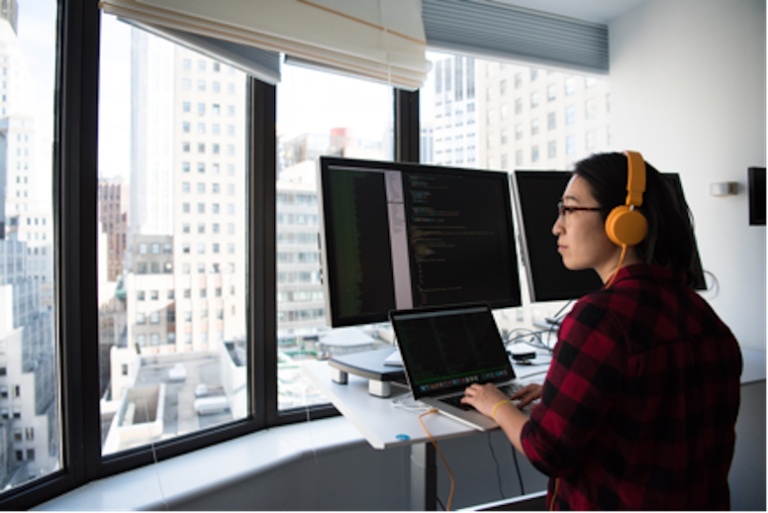6 Ways Employees Benefit from Standing at Work

A multitude of studies have been published about the adverse effects of sitting all day and the many benefits that standing (and moving) offer people. Truly optimal is the ability to shift from sitting to standing and back again. Adding in some simple movement, such as walking to the water cooler or taking the stairs instead of the elevator, can really elevate the benefits. Either way, experts in this field agree that to stay healthy, the best thing anyone can do is get out of that chair and stand up.Standing desks are a great way to provide employees with the ability to stand when they can, providing them with several benefits to their overall fitness. Sit-stand desks in particular—or other setups that mimic the ability to go back and forth between sitting and standing—provide the best of both worlds. Here are six ways employees benefit from the ability to standing at work.
1. Reduce Chronic Disease
Dr. James Levine, co-director of the Mayo Clinic and the Arizona State University Obesity Initiative, indicates that even if you are fit and regularly exercising, sitting for too long could lead to many chronic diseases and obesity. He has even published a book about it, “Get Up! Why Your Chair Is Killing You and What You Can Do About It.” Mayo Clinic published its own study conducted on more than 7,000 healthy adults between the ages of 20 to 79 years. The findings reflect a direct correlation between standing time and obesity levels: the more time an adult spends standing on his feet, the less risk of obesity he faces.
2. Increase Calorie Burn
Sedentary lifestyles lead to an accumulation of fat around our internal organs. Therefore, doctors all over the world suggest standing more than sitting for those trying to lose weight. Studies by Professor Marc Hamilton, of the University of Missouri, claim that a person’s metabolism reacts differently in standing vs. sitting positions. Just standing doubles the metabolic rate and leads to more calorie burn in individuals, whereas sitting suppresses the enzymes that are responsible for breaking down the fat and instead leads to fat storage. Dr. James Levine’s work echoes the same findings; in fact, he developed the NEAT™ Certification Program at Mayo Clinic, which measures energy expenditure (caloric burn) sitting vs. standing, and more.
3. Reduce the Chances of Diabetes and Cardiovascular Diseases
An article in the New York Times indicates the higher likelihood of heart disease in people who spend more time sitting. According to the report, people who sit for 9 to 10 hours daily are more at risk for diabetes and cardiovascular problems even if they exercise. The article also linked sitting with heart failure, as gradually the heart gets weaker and is not able to pump enough blood through the body.
4. Reduce Back Pain
Sitting for extended hours tends to put continuous pressure on an individual’s back muscles. In fact, there is 90% more pressure when sitting as compared to standing. The sedentary lifestyle today is one of the most important reasons for the growing incidences of musculoskeletal disease.
5. Increase Productivity
According to CNN.com, researchers conducted a study for six months on some employees of a call center company. These employees were provided with a standing desk at their work. Lo and behold, the productivity of the employees rose by 23% within the very first month. Another five months saw a 53% enhanced productivity in the workers. On the other hand, the workers who were not provided with the standing desks were less productive. While a 53% increase in productivity may not be a feasible figure for some professions, a general rise in productivity seems to be assured.
6. Enhance the Quality of Life
A sedentary lifestyle is known to speed up the biological aging process in individuals. Standing desk benefits are not limited to the physical fitness of an individual but also improve mental fitness. Studies indicate fewer symptoms of stress and tiredness in individuals who do not sit for prolonged hours at the workplace. The brain is more active and alert when standing in comparison to sitting. A sharp and alert mind enhances the focus in individuals leading to better work, which, in turn, can result in higher job satisfaction and a happier individual. Less risk of diseases like diabetes, obesity, and heart ailments, along with better metabolism, improves the general quality and life span for any individual.
Apart from the advantages that you gain by simply standing at work, more benefits can be added to your experience by incorporating a little movement, from taking walking meetings, to using a balance board, to incorporating standing desk exercises or Office Yoga. Even adding simple exercises to your daily routine like leg extensions, abdominal curls, calf raises, side lunges, and desk push-ups, will go a long way.
It’s not difficult to conclude that adding the ability to stand at work is an effective way for an organization to support their employee’s wellbeing. Standing desks offer a practical option, as well as other flexible solutions such as desktop converters, desktop risers, and more. Whatever solution is chosen, people benefit from standing at work, which is a win-win situation for both a company and its employees.

About the Author:
Yuying Deng is the CEO & Co-founder of Altizen (Ideal Workspace), a company that uses cutting-edge technology and sensing abilities to customize the environment for each person at the workplace, thus vastly enabling access and improving the health of our users. Yuying’s passion is to optimize workplace health and productivity. She believes that when individuals are empowered to be active and healthy, they are capable of achieving their best.
Interested in writing a guest post for the FluidStance blog? Have suggestions for topics? Email us at flow@fluidstance.com


Leave a comment